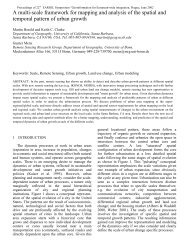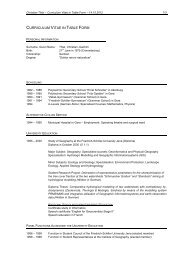Using Geomatica Software - Fernerkundung Jena - Friedrich ...
Using Geomatica Software - Fernerkundung Jena - Friedrich ...
Using Geomatica Software - Fernerkundung Jena - Friedrich ...
You also want an ePaper? Increase the reach of your titles
YUMPU automatically turns print PDFs into web optimized ePapers that Google loves.
slow: on a Sun SPARCstation LX the evaluation rate is 1440 pixels per second for a<br />
model with 83 GCPs. The other disadvantage of TPSs is that they reproduce exactly<br />
(within numerical computation errors) the values at all GCPs. Therefore the method does<br />
not provide direct means of detecting and correcting errors in GCP coordinates. To verify<br />
the derived transformation, an independent set of Check Points must be acquired and<br />
their number should be large enough to ensure a thorough verification (say, half the<br />
number of GCPs). This obviously increases the total cost of the approach, or may<br />
compromise the quality of the final product if the number of check points is low. To<br />
summarize, Thin Plate Spline warping is recommended for distortions that can be<br />
accurately represented by up to several tens of ground control points. It is not<br />
recommended for removal of terrain distortion, for which an analytical approach should<br />
be used. The analytical approach is based on a photogrammetric model of the viewing<br />
geometry and uses terrain elevations from a Digital Elevation Model of the area.<br />
Satellite Ortho Model:<br />
The Satellite Ortho Model is the geometric model used in the PCI PACE Satellite Ortho<br />
and DEM package. In GCPWorks, it is only enabled when the user selects the Satellite<br />
Ortho Correction Mathematical Model from the GCPWorks Setup panel. It should be<br />
noted that the residual errors reported in GCPWorks are in PIXEL unit on the raw image,<br />
assuming the input geocoded coordinates are correct. This is equivalent to setting<br />
ERRUNIT=PIXEL inside the SMODEL program of the satellite ortho package. The<br />
polynomial transformation method, in comparison, does not reflect the distortions due to<br />
the image acquisition and relief displacements. The polynomial transformation method is<br />
limited to small areas with at terrain and requires a lot of GCPs. The PCI satellite ortho<br />
model only requires a minimum of three to four accurate GCPs for visible images (such<br />
as SPOT and Landsat) and seven accurate GCPs for RADAR images (such as ERS and<br />
RADARSAT). The geometric modelling was developed by Dr. Thierry Toutin, at the<br />
Canada Centre for Remote Sensing. The model requires a minimum of 4 and 7 GCPs for<br />
VIR (such as Landsat, SPOT, IRS) and SAR images, respectively. However, if the GCPs<br />
are not very accurate, the user should collect at least 6 and 12 GCPs for VIR and SAR<br />
images, respectively. More details on satellite ortho model can be found in the<br />
Registration Scenarios section. Also see the Satellite Ortho & DEM manual, and the<br />
Orthorectification and DEM Extraction chapter of the <strong>Using</strong> PCI <strong>Software</strong> manual.<br />
Resampling:<br />
Resampling is a process that involves the extraction and interpolation of grey levels from<br />
pixel locations in the original uncorrected image. There are several methods of<br />
interpolation which can be applied: nearest neighbor, bilinear interpolation, cubic<br />
convolution, 8-point Sin(x)/x, and 16-point Sin(x)/x. During bilinear interpolation, cubic<br />
convolution and sin(x)/x, the last pixel and/or scanline will be reused to produce the grey<br />
level values for the georeferenced image if the uncorrected pixel window used to<br />
calculate the corrected matrix grey level value falls outside the bounds of the<br />
uncorrected image at its corner edges. This reuse of pixel values can have the effect of<br />
producing image edges which are darker or lighter than the interior of the image. In<br />
GCPWorks, the Resampling type can be set in the Disk-to-Disk-Registration, or the Preregistration<br />
Checking panel.<br />
Nearest Neighbor:<br />
Nearest neighbor interpolation determines the grey level from the closest pixel to the<br />
specified input coordinates, and assigns that value to the output coordinates. This<br />
method is considered the most efficient in terms of computation time. Because it does<br />
not alter the grey level value, a nearest neighbor interpolation is preferred if subtle<br />
variations in the grey levels need to be retained, if classification will follow the<br />
registration, or if a classified image is to be resampled. Nearest neighbor interpolation<br />
introduces a small error into the newly registered image. The image may be offset






